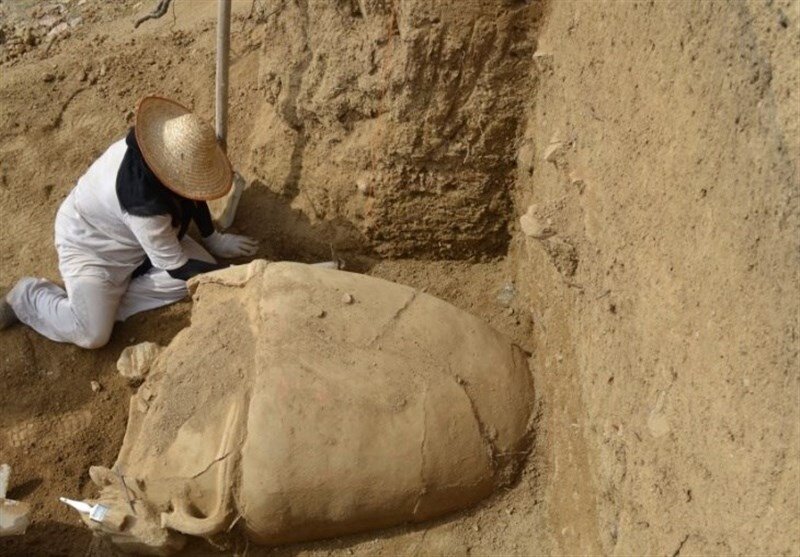Oil drilling reveals cemetery with giant urn-like tombs in southwest Iran

TEHRAN – An ancient cemetery bearing urn-like tombs has accidentally been discovered in an oil drilling project off the river Karun in Ahvaz, southwest Iran.
Situated about 150 meters from the river, the cemetery has yielded ancient human remains some beige-colored urn tombs that are coated with natural tar, Iranian archaeologist Hossein Feizi told ILNA on Tuesday.
The urn tombs face the river, suggesting a hypothesis that those burials were made according to Mithraism principles.
“The fact that this type of burial is toward the river strengthens the hypothesis that this cemetery and its burials had links with Mithraism,” the archaeologist said.
Mithraism was a sect of Zoroastrianism characterized by the worship of Mithra as the defender of the truth, and it was a monotheistic mystery religion prevalent in the Roman empire before the acceptance of Christianity in the fourth century.
Preliminary researches show the cemetery dates back to the time of the Parthian Empire (247 BC – 224 CE), which once stretched from the northern reaches of the Euphrates, in what is now central-eastern Turkey, to eastern Iran.
“This type of burial in urns was especially dedicated to babies and young children, since the Neolithic era. But the peak of the use of this burial method can be observed and followed during the Parthian period.”
As mentioned by Feizi, the newly-discovered urn tombs can be compared and contrasted with the ones previously discovered in Shoghab (cemetery) of Bushehr province.
Covering five hectares of land, Shoghab cemetery, which is located on the outskirts of Bushehr, is adjacent to other magnificent sites which date from the Elamite (3200 – 539 BC) and Sassanid (224 CE-651) eras. Previous excavations there have revealed three types of burial, including rectangular tombstones, rectangular pit tombs made of stone, and (giant) urn pits (stretched) in the east-west direction.
Elsewhere in his remarks, Feizi reminded that many researchers believe the southern parts of Khuzestan - and in particular Ahvaz and its surroundings - were once permanent settlements from the Sassanid era onwards.
“The discovery of this new cemetery in Ahvaz well indicates human settlements in the late Parthian period,” the archaeologist said.
Concerning the fact that the new discoveries are made during an oil drilling project, Cultural Heritage activist Mojtaba Gahestuni has expressed worry that the site may not be protected.
“Now, a new ancient site has been discovered in the area of an oil company's workshop, and there is a concern that this site will not be explored. This area needs to be explored, saved, preserved, and registered nationally,” ILNA quoted Gahestuni as saying on Tuesday.
Last year, a team of archaeologists discovered a rare Parthian-era (247 BC – 224 CE) tombstone in an ancient cemetery in northcentral Iran. The discovery was of high importance because it yielded the first-ever engraved tombstone of the Parthian era.
The Parthian Empire, also known as the Arsacid Empire, was a major Iranian political and cultural power in ancient Iran. The Parthians largely adopted the art, architecture, religious beliefs, and royal insignia of their culturally heterogeneous empire, which encompassed Persian, Hellenistic, and regional cultures. At its height, the Parthian Empire stretched from the northern reaches of the Euphrates, in what is now central-eastern Turkey, to eastern Iran.
Parthian wealth obtained through lucrative trade networks resulted in substantial patronage of the arts, in particular, relief sculpture, statuary (large and small scale), architectural sculpture, metalwork, jewelry, and ceramics; coins with images of Parthian rulers form another important category of objects.
A cradle of civilization, Iran is well soaked in history and culture, and never disappoints cultural travelers with almost every taste even ones interested in cemetery tourism.
Having nearly all kinds of historical tombs, museums such as tomb towers, and rack-hewn tombs, Iran is heaven for cemetery enthusiasts and grave hunters; individuals who have a passion for and enjoyment of cemeteries, epitaphs, gravestone rubbing, photography, art, and history of famous deaths.
In cemetery tourism, contrary to popular belief, it is you who will be the protagonist of a hot dialogue of past and present during visits to centuries-old tombs or cemeteries instead of listening to a curator of an exhibition!
AFM
Leave a Comment